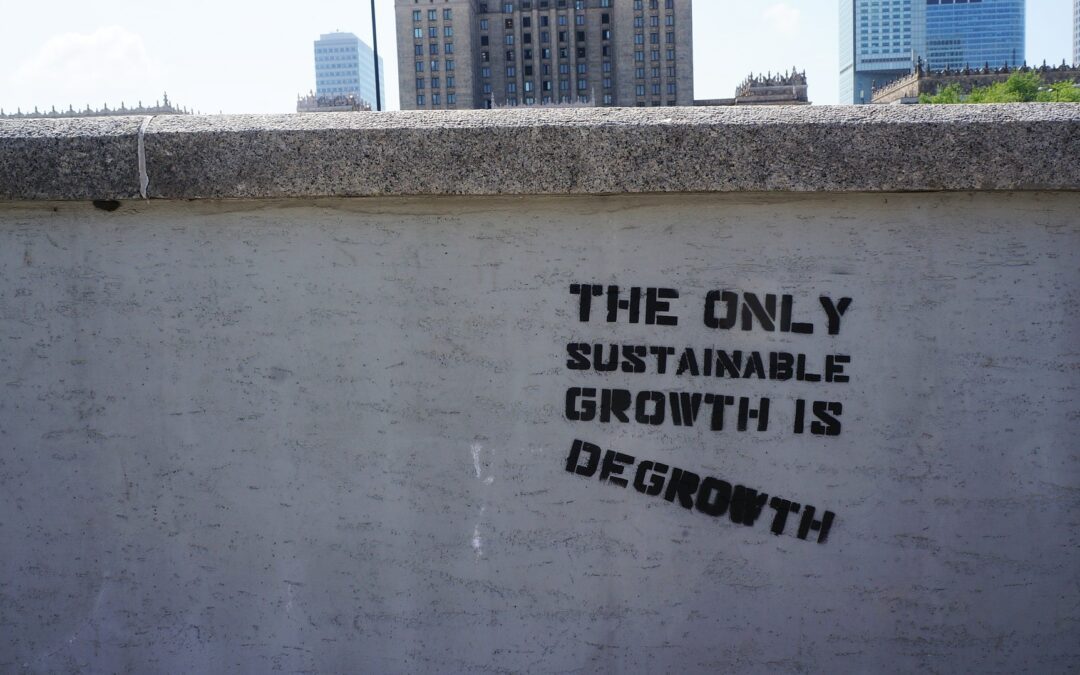Seven years after the ratification of the Paris Agreement in 2015, global GHG emissions are still on the rise. A drop was recorded in early 2020 following the pandemic spread of COVID-19. Nevertheless, emissions quickly returned to their pre-pandemic levels, reaching levels never recorded before [1]. However, countries’ overall wealth is also increasing. Gross Domestic Product (GDP) is used to measure a country’s size and economic growth, or in other words, its level of wealth [2]. Of course, some countries GDP is growing faster than others. While in others, the value of GDP tends to fall. However, overall, the average value of GDP has been rising since the 2nd World War. Traditionally, if GDP stagnates or falls, then the country is in recession; in other words, things are going badly! However, in 2017, 82% of the new wealth created worldwide ended up in the bank accounts of the wealthiest 1% of people [3], deepening inequality.
Our economic system is based on perpetual growth
To generate this growth, we need to consume more, and therefore produce more. This linear model also relies on the extraction of natural resources to produce what we consume, but also to package and transport goods. This quest for growth means that resources are exploited faster than they can be regenerated. In 2021, the world’s exceedance day took place on July 29 [4]. This date marks the exhaustion of the planet’s annual resource budget: in 2021, it will have taken us 6 months and 28 days to consume all the resources the planet can generate in a year. Our frantic pace of consumption is pushing us to dip into the resources that the Earth has been storing up for thousands of years since we’re not respecting the “budget” it allocates to us annually. It makes you wonder whether this desire for infinite growth is possible on a planet with finite resources.
In 1972, this is exactly what the Meadows Report underlined in its exhaustive document entitled “Stop Growth…”. In it, the group of scientists highlighted the risks of environmental and economic catastrophe associated with the quest for infinite growth based on finite resources. This completely ignored warning calls for ecosystems’ threshold capacity to meet human needs to be taken into account. The conclusions drawn in this report are wonderfully timeless and still relevant today [5]. Between the proliferation of the concept of sustainable development and the 26 annual international summits on the climate crisis over the last few decades, a completely different current of thought has emerged. It is gaining ground internationally: that of degrowth.
The idea of degrowth brings about a drastic paradigm shift
It rejects the foundations of our current economic system. The movement calls for a contraction of the world’s economies in order to relieve anthropogenic pressures on natural ecosystems. The degrowth specialists propose producing less, owning fewer material possessions and choosing goods that are more durable and easy to repair [6]. In this way, our global activities would be much less extractive, and our production of waste would decrease drastically. By consuming less, we would have to produce less and therefore work less. We would have more free time to devote to our families and friends, to get involved in the upkeep of a collective garden or the exchange of goods and services, for example [7].
Degrowth is not just about reducing, it’s also about doing things differently
At Will Solutions, we offer local carbon credits to offset your carbon footprint, while supporting Canadian companies, NPOs and communities that are voluntarily reducing the carbon intensity of their economic activities. Our project aims to deploy on a large scale an economy that is more respectful of planetary limits and human beings.
For proponents of degrowth, the only way to save ourselves from the catastrophic impacts of the climate crisis is to reduce economic activity. The majority of human beings would no longer be destined to work to keep the economic machine running. This change in social and economic foundations would leave less room for private enterprise so that cooperatives and self-managed businesses could operate on a larger scale. There would no longer be resource owners, but more resource managers, transforming our vision of ownership.
For example, La Remise in Montreal is a tool and appliance lending cooperative. It enables citizens to borrow round saws or machines for making fresh homemade pasta so that people don’t have to buy these items, which are only useful 2 times a year! This simple operating model is in line with the ideas advocated by degrowth since it reduces the consumption of material goods [8]. This theory also calls into question our relationship with transport and travel. The blatant desire to own a car and to travel long distances without considering the environmental and social consequences are impacts of the individualism imposed by the current economic system.
Many might think we’re in a kind of perpetual recession, but supporters of degrowth are advocating a profound transformation of economic values, and they’re doing it intentionally [9]. The transition would be away from capitalism and economic growth as a political priority. The priority would be to meet real human needs while respecting the planet’s biophysical limits and reducing social inequalities. This current of thought, which appeals to environmental activists, academics and politicians, is positioned at the anti-pole of capitalism and even criticizes the concept of sustainable development. For degrowth specialists, it’s impossible to continue growing economies even with the integration of clean technologies and energies.
After all, in an open letter signed by over 11,000 scientists, they declare that the planet is “clearly and unequivocally” in a state of climate emergency. And this state of emergency is “intimately linked to excessive consumption in affluent countries” [10].
The heated debate on degrowth
Degrowth is far from being an idea advocated by everyone. Many criticize it for being a far-fetched utopia. Critics ask whether we can solve the problem of global poverty in a system without economic growth. Then, in the years to come, most carbon emissions will come from countries emerging from development, such as China and India. The more Western countries decarbonize, the greater the share of emerging countries in global GHG emissions. So, if developing countries continue to grow to a certain level, most of the source of GHG emissions remains unaddressed. Thus, the chances of minimizing the impacts of climate change through degrowth are greatly reduced.
We have seen with the COVID-19 pandemic that the global economy is interconnected. If Western countries start to shrink and consume less, the impact of reduced imports from emerging countries could be catastrophic [9]. Growth advocates put forward the theory of decoupling, according to which, beyond a certain level of wealth, technical progress reduces pressure on the environment. They believe that this progress will ensure that climate targets are met while the economy grows [11]. Here, we can think of sustainable development: the implementation of responsible practices and technologies that help us reduce GHG emissions, but not economic activity.
Degrowth specialists would reply that consumption would be stopped in sectors that are useless or do not improve human well-being, not in all sectors. GDP is not a measure of the well-being of a country’s population, but exclusively of the size of its economy. While the installation of a petrochemical plant is positive for the country’s GDP, the emanation of its toxic particles is rather negative for the health of communities and the environment. And GDP doesn’t take that into account! It doesn’t take into account the social value added and lost, such as the skills and knowledge of the workforce, and the depletion of resources. Over the years, we’ve built up a complex economic system that is drifting away from its primary objective of meeting human needs. And many countries that have increased their GDP have failed to reduce their GHG emissions – a failed decoupling [12].
Alternative models for degrowth
Sustainable development and green growth policies have so far failed to address environmental challenges and put us on track to limit global warming to 1.5 degrees Celsius. Nevertheless, while the questions raised by degrowth are relevant, the answers are not yet fully satisfactory: how do we judge what is a need and what is superfluous? What would be the repercussions on the countries of the South and on vulnerable populations? How can these policies be implemented on a large scale? Indeed, the theory of degrowth has its limits and may seem like a radical idea. However, if we don’t act quickly to reverse the current trend, global GDP could fall by 30% per capita by 2100 compared to if there were no global warming, and this is beyond our control, as a result of the impacts of climate change on human populations [8]. What we’re going to have to deal with is degrowth!
We often hear people say they’re tired, stressed and need to slow down or take a break. Degrowth is also about slowing down. Even if we don’t apply this concept on a global scale, its ideas are worth thinking about on an individual scale. Rethinking our speeds and ways of consuming, assessing the quality of our human relationships, reviewing our relationship with transport and travel, and asking ourselves what place our hobbies and passions occupy in our lives could make way for a more restful daily routine. As a Western society, we might have to give up some of our acquired material goods, but if it’s for the sake of having more free time, being more connected with others and navigating a more equitable society, it might just be worth it.

Alexie Roy-Lafontaine
Scientific writer for the web and social networks
Article author

